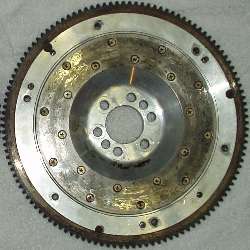The MGA With An Attitude
So You Want a LIGHT WEIGHT FLYWHEEL? - FW-201
At 08:57 AM 12/3/04 -0700, Joshua Juel wrote:
"HI had originally planned to merely upgrade from the original flywheel to an early MGB unit, but as I was fortunate enough to find a few extra bucks in my car budget in the upcoming year, thought I might go a step further and go aluminum (not to mention I've been able to source it for about $300)."
After an immediate knee jerk reaction over the price, I have to ask, uh, .... why?
There is a reason that a flywheel has size and mass. It makes the car friendly and easier to drive in normal driving conditions. It stores enough energy that with just a little slippage of the clutch you can get the car moving from a dead stop with engine speed barely off of idle.
Times change and traditions change, so a moderate reduction in weight of flywheel may give the car a lively and more spirited feel and a bit better accelleration. With just a little extra throttle you can still get the car moving. But you still need a flywheel, and there is some practical limit to the weight reduction.
 For a competition car, minimal mass in the flywheel may make for fastest lap times, and every little bit helps. But an extremely light flywheel can be hard to drive on the street. With a very light flywheel, to get the car moving from a dead stop you need either a lot of clutch slippage or a higher throttle setting to prevent stalling the engine. Common result is reving the engine to 2000 rpm and spinning the tires a little off the line to prevent killing it. A combination of very light flywheel and competition clutch is very tricky driving around town. The picture here is an aluminum flywheel with a steel insert for the wear surface. This is that larger 127 tooth flywheel for the 1968 and later MGB 4-syncro gearbox with pilot diameter and bolt pattern for the five main bearing crankshaft, steel thread inserts, and three alignment pins for the MGB type pressure plate.
For a competition car, minimal mass in the flywheel may make for fastest lap times, and every little bit helps. But an extremely light flywheel can be hard to drive on the street. With a very light flywheel, to get the car moving from a dead stop you need either a lot of clutch slippage or a higher throttle setting to prevent stalling the engine. Common result is reving the engine to 2000 rpm and spinning the tires a little off the line to prevent killing it. A combination of very light flywheel and competition clutch is very tricky driving around town. The picture here is an aluminum flywheel with a steel insert for the wear surface. This is that larger 127 tooth flywheel for the 1968 and later MGB 4-syncro gearbox with pilot diameter and bolt pattern for the five main bearing crankshaft, steel thread inserts, and three alignment pins for the MGB type pressure plate.
"I'll attach a link for you that shows all the offerings from Fidanza, but my question is: what is the difference between #126991 and the multi-disk unit #126997?" https://www.nolimitmotorsport.com/fidanza/apps-MG.html
Apparently 126991 is a direct replacement for the original flywheel. The 126997 is for use with a multi-plate clutch. I suppose it may have a different bolt pattern to accomodate the special pressure plate.
The arrangement of part numbers there is a bit confusing related to model years, maybe even misleading. The MGA 1500 and 1600 use identical flywheels. The MGA MK-II car in 1961-1962 had a lighter flywheel nearly identical to the early MGB. MGB uses 3 alignment pins for the clutch cover where the MGA uses 2 alignment pins. Otherwise the 1955-1964 flywheels are physically interchangeable.
For street use I like the lighter flywheel (about 8 pounds lighter) from the late production MGA 1600-MK-II or the early MGB. I also like the action of the MGB pressure plate, especially with a slightly uprated engine. I would advise against the aluminum flywheel or competition pressure plate for daily street use.
|